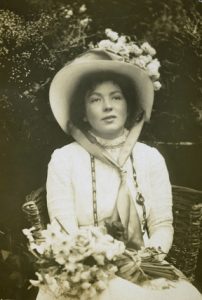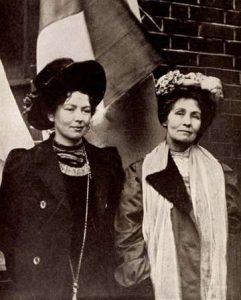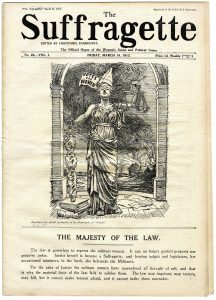Christabel Pankhurst (1880-1958)
“Remember the dignity of your womanhood. Do not appeal, do not beg, do not grovel. Take courage, join hands, stand besides us, fight with us”
Christabel Pankhurst (1880-1958) was a major figure in the British women’s suffragette movement in the early 1900s. She was one of the daughters of Emmeline Pankhurst (1858-1928). Together with mother and her sister Sylvia Pankhurst (1882-1960) she the Women’s Social and Political Union (WSPU) in 1903, the main suffrage organization that performed and organized the militant strategies such as hunger strikes, window smashing, and arson to get women the right to vote.
Christabel Pankhurst was born in September 1880 as the eldest child of the four children of Emmeline and Richard Pankhurst. Both her mother and father were liberal socialist and active proponents of women’s suffrage. Her mother, Emmeline, is well known as the champion of women’s suffrage in the United Kingdom and for her advocacy of militant tactics. In her decades-long crusade for women’s suffrage, she established first the Women’s Franchise League in 1889 and helped co-found the WSPU. Christabel’s father, Richard Pankhurst (1835-1898), was a well-known associate of the liberal politician John Stuart Mill (1806-1873), author of On the Subjection of Women (1869). He also drafted several important and successful laws that expanded women’s rights, such as the Municipal Franchise Act and the Married Women’s Property Act.
The Pankhurst family was a middle-class family that stressed the importance of education. Richard Pankhurst as a lawyer, and Emmeline Pankhurst as a political activist, gave their children a good education early on. As a child, Cristabel Pankhurst learned to read at home before she attended school. After attending Manchester High School for Girls, she went on to obtain a law degree from the University of Manchester. Despite her receiving honors on England’s law examination, she was unable to practice because of her gender.
The prejudice against her as a lawyer and her parents’ political activism likely had much influence on Christabel’s involvement in the women’s suffrage movement. In 1900, the Labor Party voted for equal suffrage, which would give women equal rights to vote like men, only in a second step they would campaign for their long-term goal, universal suffrage for all men and women. Both Emmeline and Christabel Pankhurst disagreed with the decision that only after the Labor Party had secured women’s equal right to vote with the men the party should go on to advocate for universal suffrage. These beliefs prompted them to form the WSPU in 1903, which fought for the equal conscription of men and women using militant tactics. They believed that the passive tactics—such as—that had been used thus far in attempting to persuade the British government had not been successful and would continue to be unsuccessful. Because the suffrage movement was losing media attention, they implemented more violent tactics of civil disobedience that, though they did not obtain them the vote immediately, brought major publicity to the WSPU.
Christabel Pankhurst and her friend Annie Kenney were the first two women arrested for using militance in order to be heard. At a 1905 speech by a British government member, the two women shouted demands for equal rights. When the police attempted to evict them from the area, the two women refused to leave. They were arrested because the police claimed that they spat on him and kicked on him. Though that is uncertain, Pankhurst and Kenney’s arrest startled the nation because it was the first militant act of suffragist women. They sparked the publicity boost that followed the WSPU. Both women served their sentences (Pankhurst’s was one week and Kenney’s was three days), and left prison to continue their involvement with the WSPU. Pankhurst was arrested again in 1907 and 1909. In 1910, when the WSPU decided to increase the level of violence beyond rallies and protests to destroying property, she, as one of the most prominent speakers for WSPU and labeled “The Queen of the Mob,” became a major target from the police. She moved to Paris for one year in order to avoid being arrested. Nevertheless, when she returned in 1913, she was arrested, though she only served a sentence of thirty days.
Christabel Pankhurst also took over the editing of the WSPU newspaper Votes for Women upon her return from France after Frederick and Emmeline Pethick Lawrence, who had edit it since 1903. They were dismissed from the organization because of their resistance against the militant tactics. The WSPU renamed the organization’s newspaper to the The Suffragette and Christabel Pankhurst took on the editing and promotion of more militant tactics. She also wrote The Great Scourge and How to End It in 1913 after her stint in Paris. The book focused on how women’s sexual equality would help fight against sexually transmitted diseases.
Frederick and Emmeline Pethick Lawrence, co-founders of the WSPU, were not the only ones who disagreed with some of the WSPU principles. Christabel and Sylvia Pankhurst disagreed too on how the organization was promoting the votes and the exclusion of working-class women. Christabel Pankhurst argued for women’s suffrage “on the same basis as men,” which at that time excluded working class men. Sylvia was a proponent for universal suffrage that promoted the right to vote for all, no matter what class or gender. This argument caused major tensions between the sisters. When Sylvia was dismissed from the WSPU, the two did not contact each other until 1953.
When the First World War started, Christabel and her mother advocated for women’s active support of the war effort and a suffrage truce until the war was over. They dissolved the WSPU in 1917 and made it into simply “The Women’s Party,” while changing the name of the newspaper from The Suffragette to the less provocative Britannia. After the war, in 1918, when all men and women above the age of thirty were granted the right to vote in Britain, Christabel Pankhurst was one of seventeen women who ran in the General Election under the Woman’s Party. John Davidson of the Labor Party defeated her by only 775 votes.
During her later life, Pankhurst focused more on religion. She and her mother moved to Canada in 1921 and she became a part of the Second Adventist Movement. After moving to California a few years later, she became a prominent speaker and author on her religion. In 1926, Christabel and Emmeline attempted to open a teashop in the French Riviera, but it failed and in 1926 they moved back to England. Sylvia Pankhurst was declared a Dame in 1936 for her aid to the suffrage movement. Three years later, she returned to the United States, again focusing on her religious involvement until she died in 1958.
Although Christabel Pankhurst is often shadowed by her mother Emmeline Pankhurst, it is people like her who make the progress possible. It is never only the main figurehead of movements that cause them to happen. Of course, her mother played a prominent role, but the work of lesser-known leaders such as Christabel Pankhurst is just as vital to causes like the suffragette movement. Though many disagreed with the militant tactics, the women like Christabel Pankhurst who took part in the suffragette movement, made people understand that women were passionate and willing to do almost anything for equal rights.
Shana Loudermelk, History and Psychology, Class of 2019
Sources
Literature and Websites
- “Christabel Pankhurst.” Wikipedia, at: https://en.wikipedia.org/w/index.php?title=Christabel_Pankhurst&oldid=828135017 (Accessed 22 April 2018).
- “Emmeline Pankhurst.” Spartacus Educational, at: http://spartacus-educational.com/WpankhurstE.htm (Accessed 22 April 2018).
- “Women’s Social and Political Union.” Wikipedia, at: https://en.wikipedia.org/w/index.php?title=Women%27s_Social_and_Political_Union&oldid=836170801 (Accessed 22 April 2018.
- Nym Mayhall, Laura. “The Ethics of Resistance, 1910-1914.” In The Militant Suffrage Movement: Citizenship and Resistance in Britain, 1860-1930, 98–116. Oxford University Press, 2003.
- Simkin, John. “Christabel Pankhurst.” Spartacus Educational, at: http://spartacus-educational.com/WpankhurstC.htm (Accessed 22 April 2018).
- Trueman, C N. “Christabel Pankhurst.” The History Learning Site, at: https://www.historylearningsite.co.uk/the-role-of-british-women-in-the-twentieth-century/christabel-pankhurst/ (Accessed 22 April 2018).
Images




